A Desert Locust outbreak continues in western Mauritania where ground control operations are in progress against hopper bands and groups of hoppers and adults within an area of about 300 km by 200 km between Nouakchott and Atar as well as along a 100 km stretch of coast south of Nouakchott. Breeding has extended into the southern portion of the Western Sahara in the extreme south of Morocco where hatching occurred and limited control operations are underway against small hopper bands that are forming. Another generation of breeding could occur in Mauritania if temperatures remain warm.
More groups, bands and perhaps a few small swarms are expected to form in the outbreak area. Adult groups and perhaps a few small swarms may move progressively northwards during periods of warm southerly winds and reach northern Mauritania and adjacent areas of the Western Sahara where breeding will occur in areas that received heavy rains in October.
Elsewhere in the region, scattered adults persist along the southern side of the Atlas Mountains in Morocco and in western Algeria. Small-scale breeding continues in the extreme south of Algeria near the Malian border where control was carried out. In northern Niger, local breeding occurred in Tamesna and the Air Mountains and limited control was undertaken recently.
In the Central region, small local outbreaks developed on the Red Sea coast in Eritrea and Yemen while a short-lived outbreak from last month subsided in Sudan. Ground control operations are in progress in both countries but limited in Yemen due to insecurity. Small-scale breeding will cause locust numbers to increase along both sides of the Red Sea and Gulf of Aden coasts during December.
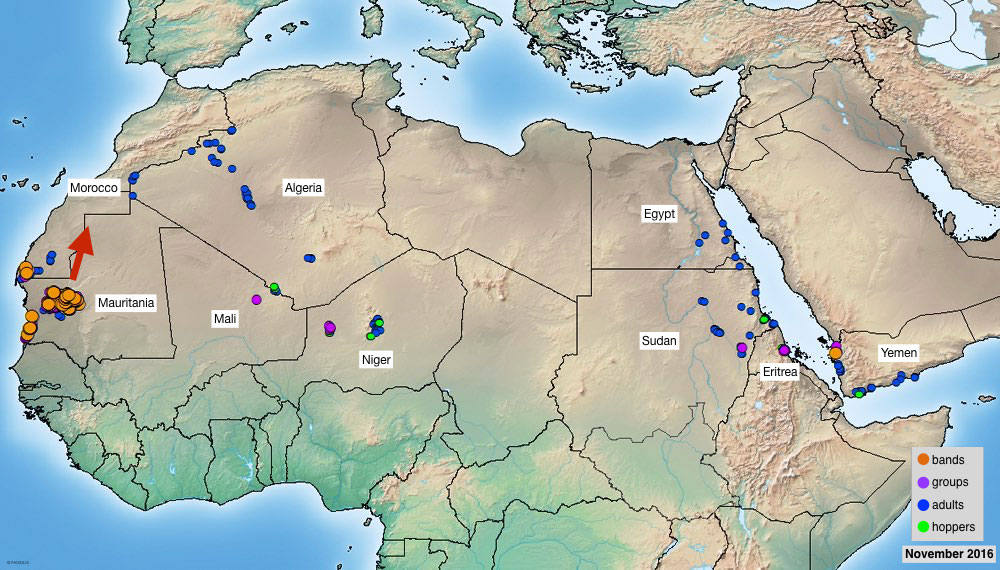
Current situation.
3 November. Desert Locust outbreaks in progress in Mauritania and Sudan
As a result of summer breeding, two Desert Locust outbreaks are currently in progress, one in western Mauritania and one in northern Sudan. In both countries, additional survey teams have been mobilized and control operations are underway.
In Mauritania, the outbreak is confined to the western part of the country between Nouakchott, Tidjikja and Atar where widespread breeding by scattered adults, groups and a few swarms in October resulted in the formation hopper groups and bands. Ground teams in Mauritania have treated nearly 8,500 ha since the beginning of the campaign in late September. Smaller infestations were seen in adjacent areas of Western Sahara in southern Morocco where limited control operations were carried out against adult groups.
A new generation of adults will form groups and small swarms from about mid-November onwards in western Mauritania. It is likely that the outbreak will extend into areas of recent heavy rains in the north of the country as well as in Western Sahara where breeding and limited control operations are in progress. A failure to control the outbreak combined with any unusually heavy and widespread rainfall might eventually lead to an upsurge in northwest Africa next spring but this is far from certain.
In Sudan, an outbreak developed in North Kordofan and the Baiyuda Desert as a result of summer breeding and drying conditions. The outbreak may extend east of the Nile Valley. Ground and aerial control operations have treated nearly 3,000 ha of hopper groups and bands so far. Some of the hoppers have already fledged and immature adults are forming groups and perhaps a few small swarms that will move to the winter breeding areas along the Red Sea, initially to northeast Sudan and southeast Egypt where good rains fell in later October that will allow adults to mature and lay eggs.
Elsewhere, the situation remains calm. Locust numbers are declining in the summer breeding areas of the northern Sahel in Mali, Niger and Chad. Limited control operations have been carried out in southern Algeria on the border of Mali. Breeding is in progress and will continue on the Red Sea coast of Eritrea and Saudi Arabia.
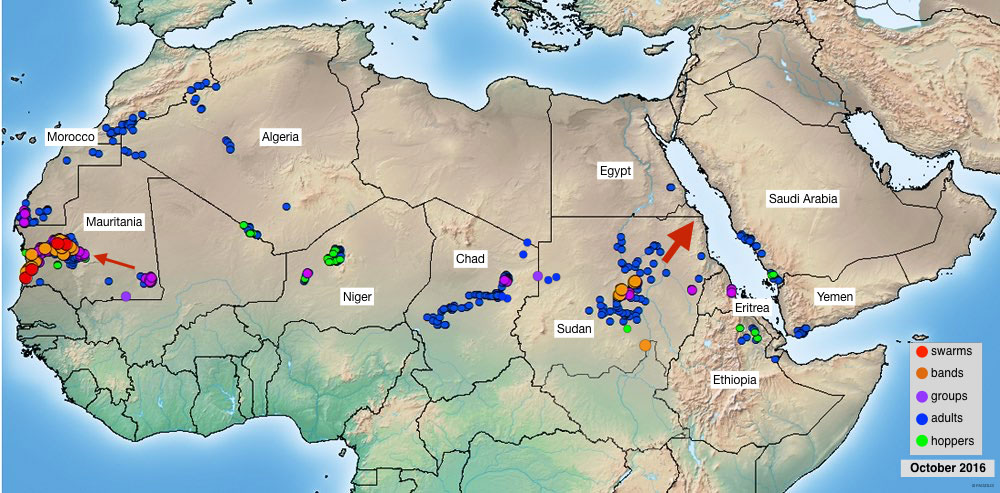
Current situation.
21 October. Outbreak continues in Mauritania and could develop in Sudan
A Desert Locust outbreak continues in western Mauritania where groups of mature adults are present, and egg-laying and hatching are underway, causing early instar hopper groups and small bands to form. Ground control operations are in progress and have treated nearly 6,500 ha since the beginning of the campaign.
In Morocco, solitarious adults are present in the Adrar Settouf area of the extreme south as well as further north along the southern side of the Atlas Mountains.
During November, locusts will decline in southeast Mauritania as a few remaining groups form and move to the northwest where they will supplement egg-laying that started during the last week of September. Second-generation hatching that commenced in early October will continue during November, giving rise to hopper groups and bands throughout October and November. Fledging is expected to commence during the second week of November and continue during December, giving rise to immature adult groups and swarms from about mid-November onwards. Seasonal rainfall predictions suggest slightly above average rainfall in November and December that should allow the continuation of favourable conditions for locust breeding and survival. Some of the infestations are likely to extend to adjacent areas of southern Morocco.
In Sudan, groups of gregarious late instar hoppers are forming in North Kordofan and hopper bands formed northwest of Khartoum in the Baiyuda Desert. Groups of hoppers and immature adults were also seen further east near Kassala. Control operations are in progress and have treated at least 500 ha so far. As vegetation dries out, more groups, bands and perhaps a few small swarms are expected to form and move to the winter breeding areas.
Elsewhere, small-scale breeding continues in parts of northern Niger where small grops are present, and locust infestations are declining in Chad.
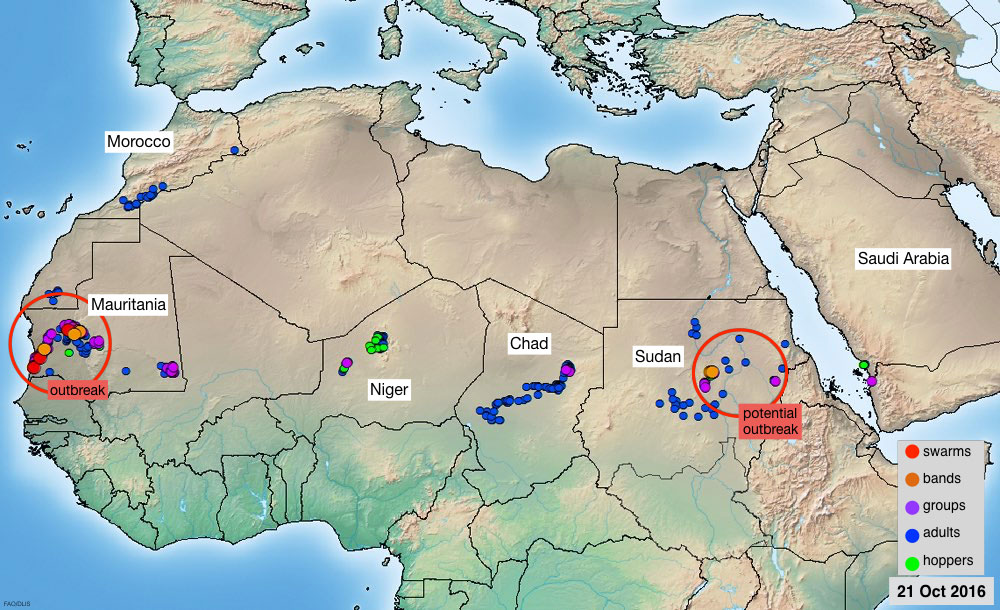
Current situation.
15 October. An outbreak develops in Mauritania as summer rains end and vegetation dries out
An outbreak has developed in western Mauritania and seasonal rains have ended in the Desert Locust summer breeding areas in the Sahel of West Africa and Sudan. As annual vegetation continues to dry out, Desert Locusts are concentrating and forming groups in those areas that remain green. This is most evident in Mauritania but it is also occurring on a smaller scale in northern Niger, northeast Chad and northern Sudan.
In southeast Mauritania, groups of adults are forming near Nema. In early October, several small swarms and groups of mature solitarious and transiens adults appeared in western Mauritania (Trarza, Adrar and Inchiri). Egg-laying and hatching were already underway in this area, and small first and second instar hopper bands have formed. So far, ground control operations have treated more than 4,200 ha up to 10 October. In southern Morocco, scattered adults appeared in the Adrar Settouf.
The infestations arriving in western Mauritania are the result of summer breeding in the south where widespread rains fell in the past few months, causing vegetation to be green much further north than usual. In addition, breeding certainly occurred in northern Mali but surveys could not confirm its extent or scale because of insecurity. As vegetation dries out in both areas, adult groups and a few more small swarms are likely to move to NW Mauritania and breed in areas of recent rainfall, extending into southern Morocco. Consequently, groups of hoppers and adults as well as hopper bands and small swarms are expected to form during the next three months. All efforts should be made to control these infestations.
Vegetation was also drying out in other summer breeding areas of the northern Sahel in West Africa and Sudan. In Niger, locust numbers increased recently on the Tamesna Plains and along the western side of the Air Mountains where at least one group of immature adults has formed. In Chad, locusts are concentrating in the northeast where one small group of hoppers was reported. In Sudan, locusts are concentrating and forming a few groups and late instar hopper bands in North Kordofan and north of Khartoum in the Baiyuda Desert where control operations are expected to commence shortly.
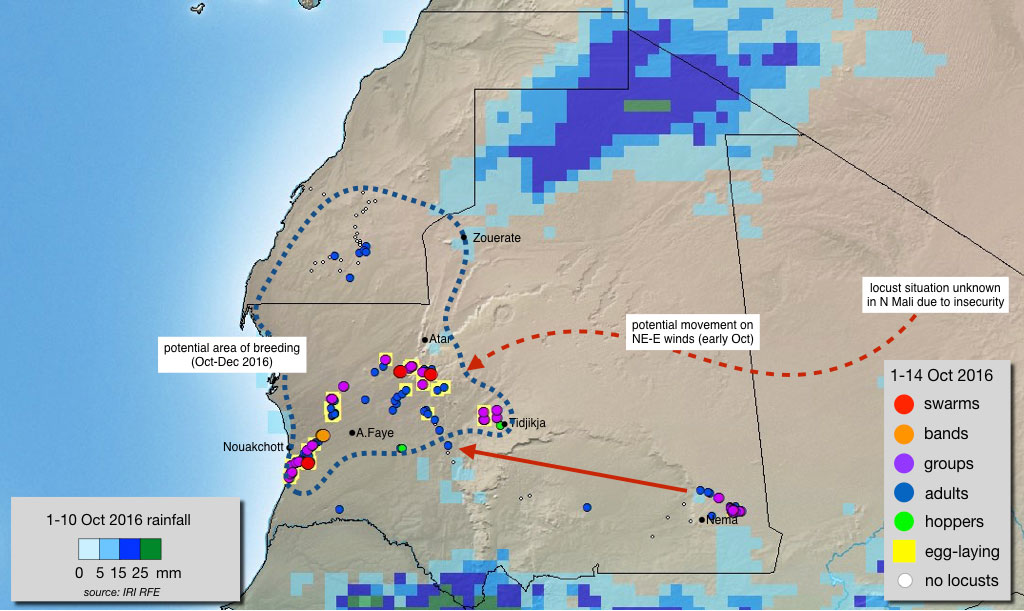
Current situation.
3 October. Situation remains serious in Yemen; outbreak likely in Mauritania
The Desert Locust situation remains very serious in Yemen and there are signs that an outbreak is developing in northwest Mauritania.
In Yemen, hopper groups, bands and adult groups continue to form in the interior and on the southern coast. Only limited survey and control operations could be carried out due to insecurity. An increasing number of adults appeared on the Red Sea coast of the country, and ground and aerial control operations treated 3,000 ha of hopper groups, bands and adult groups in adjacent coastal areas of Saudi Arabia. More adult groups and perhaps a few small swarms are expected to form in southern Yemen and will move to the Red Sea coast of Yemen and Saudi Arabia, and perhaps cross the Gulf of Aden to the Horn of Africa in northern Somalia, Djibouti and Ethiopia. Breeding will cause a further increase in locust numbers in the coming months.
In Mauritania, there was a sudden increase in locust densities in the summer breeding areas of the south, causing adult groups to form from mid-September onwards. An increasing number of adults and groups subsequently appeared in the northwest where they laid eggs. Hatching is imminent and an outbreak is likely to develop by mid-October, with a possibility of small hopper bands and swarms.
As vegetation dried out elsewhere in the summer breeding areas of the northern Sahel in West Africa and Sudan, a few groups formed in western Mali, northeast Chad and the interior of Sudan. Large numbers of grasshoppers were also present in several countries.
In Southwest Asia, the situation remains calm.
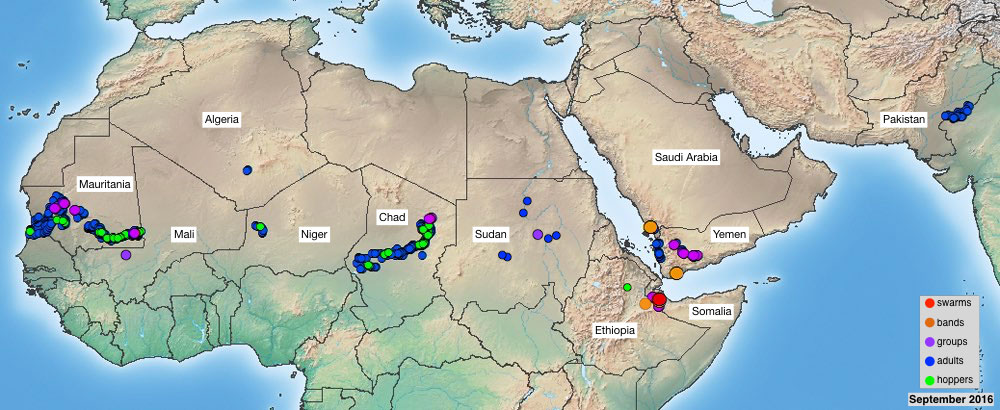
Current situation.
2 September. Hopper bands form in Ethiopia and N Somalia from earlier swarm coming from Yemen
Dozens of small hopper bands have formed in the railway area of eastern Ethiopia and in adjacent escarpment areas of northwest Somalia. The bands are a result of a few small swarms that arrived from Yemen in late July and early August and laid eggs. The swarm movement from Yemen coincides with a similar movement to Pakistan at about the same time. Ground control operations were carried out in Pakistan and are currently underway in Ethiopia. Limited operations are expected to start shortly in northwest Somalia using biopesticides.
In Yemen, the situation remains very serious because of good rains and the inability to undertake survey and control operations due to insecurity. Another generation of breeding is in progress with hopper bands forming in the interior and on the southern coast near Aden. There remains a moderate to high risk that more adult groups and swarms could form in these areas and move through the highlands and onto the Red Sea coast and into adjacent areas of Saudi Arabia while other swarms could move to the Horn of Africa. All countries should remain extremely vigilant.
Elsewhere, the situation remains calm. Low numbers of adults are widely distributed throughout the summer breeding area of the northern Sahel in West Africa and Sudan, and along the Indo-Pakistan border due to widespread rainfall and favourable ecological conditions. Small-scale breeding will continue in these areas, causing locust numbers to increase. By mid-October, a few adult groups could appear in west and northwest Mauritania as vegetation dries out.
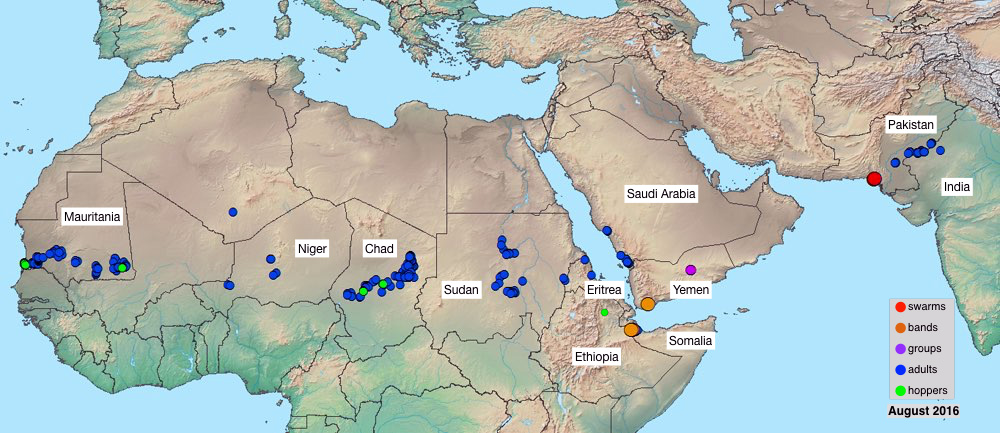
Current situation.
12 August. Hatching & band formation on Pakistan coast from earlier than previously reported swarm
New information indicates that the small mature swarm reported on 3 August on the coast of Pakistan in the Uthal area west of Karachi probably arrived at least one week earlier than previously thought.
In recent interviews, locals say they saw a mature swarm on 27 July. Prior to that, ground surveys did not detect any swarms on 16-21 July. Currently, hatching is in progress in the Uthal area and first and second instar gregarious hoppers are present. These facts suggest that at least one swarm departed from eastern Yemen on about 18-23 July and migrated for four days on strong southwesterly monsoon winds over the Arabian Sea, arriving on the coast of Pakistan about 22 July or shortly thereafter. Upon arrival, the swarm dispersed, mixed with local solitarious hoppers and adults, copulated and laid eggs that hatched from 3 August onwards. So far, ground teams have treated 220 ha. Some adults from the swarm have continued northeast to the Indus Valley where they were seen near Sukkur on 10 August.
A few more small swarms may appear in the Uthal area or along the Indo-Pakistan border but it is difficult to say with precision as the current situation in Yemen remains unclear. Increased vigilance is required in Tharparkar, Nara and Cholistan deserts of Pakistan and in West Rajasthan, India.
In addition, there remains a low risk that a few small swarms from Yemen could also appear at times in adjacent areas of Saudi Arabia and Oman or move to northern Somalia, Djibouti, Ethiopia and Eritrea. All of these countries should remain extremely vigilant during August and September.
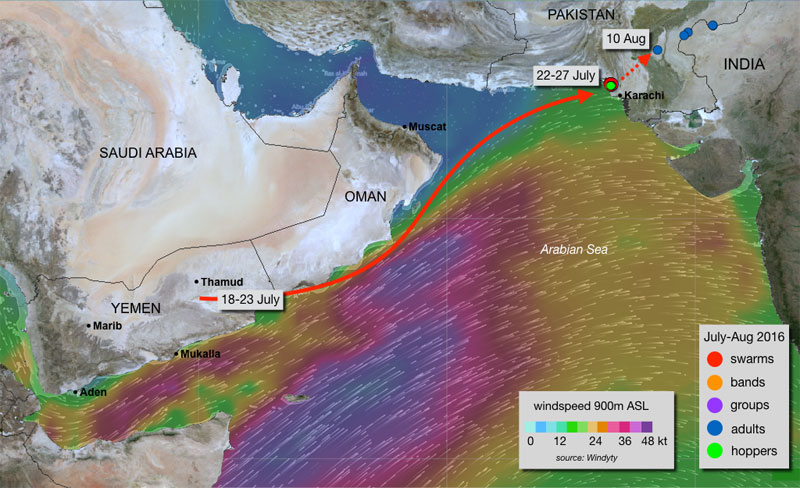
Earlier swarm migration from Yemen to Pakistan than previously thought.
9 August. Mature swarm arrives on Pakistan coast from Yemen
On 3 August, a small mature swarm arrived on the coast of Pakistan in the Uthal area west of Karachi. DLIS first provided early warning of this threat to Pakistan on 18 May. Local breeding has been in progress near Uthal since mid-July. Upon arrival, the swarm dispersed, mixed with local solitarious hoppers and adults, copulated and laid eggs. Ground control operations were immediately launched and 200 ha have been treated as today. The swarm most likely originated from recent breeding in Yemen and migrated for 3-4 days on strong southwesterly monsoon winds over the Arabian Sea. Although good control mortality was achieved, it is likely that egg-laying could not be entirely prevented. Consequently, hatching is expected to start about mid-August with a risk that small hopper bands could form.
A few more small swarms may appear in the Uthal area or along the Indo-Pakistan border but it is difficult to say with precision as the current situation in Yemen remains unclear. In addition, there remains a low risk that a few small swarms from Yemen could also appear in adjacent areas of Saudi Arabia and Oman or move to northern Somalia, Djibouti, Ethiopia and Eritrea. All of these countries should remain extremely vigilant during August and September.
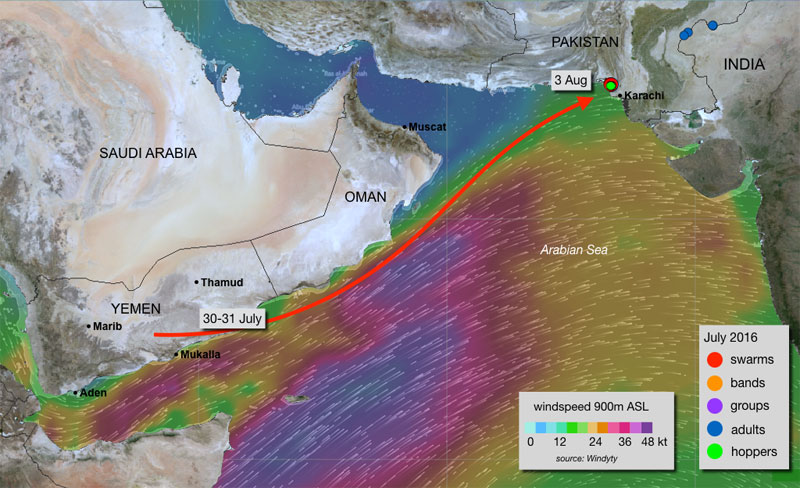
At least one swarm migrated from eastern Yemen to Pakistan.
2 August. Swarms and flooding in Yemen
The Desert Locust situation continues to be a cause for major concern in Yemen and it is potentially very dangerous. An unknown amount of breeding occurred in the interior during July and swarms formed. At least one swarm moved to the central highlands while adult groups moved to the southern coast, and scattered adults appeared on the Red Sea coastal plains. Heavy rains and flooding occurred at the end of July that will allow further breeding. Survey and control operations could not be carried out in July due to prevailing insecurity and logistical difficulties.
During August, most of the swarms are likely to remain in the country and lay eggs in areas of recent rainfall on the Red Sea coast and in the interior where hatching and band formation are expected. There is a low risk that a few small swarms could appear in adjacent areas of Saudi Arabia and Oman or move to northern Somalia, Djibouti, Ethiopia and Eritrea. These countries should remain vigilant during August and September.
Elsewhere, the situation is calm. Scattered adults appeared in the summer breeding areas of Mauritania, Niger, Sudan, India, Pakistan and perhaps Mali during July. Small-scale breeding will occur in the northern Sahel from Mauritania to Eritrea and along the Indo-Pakistan border with hatching during August. This will cause locust numbers to increase slightly but remain below threatening levels.
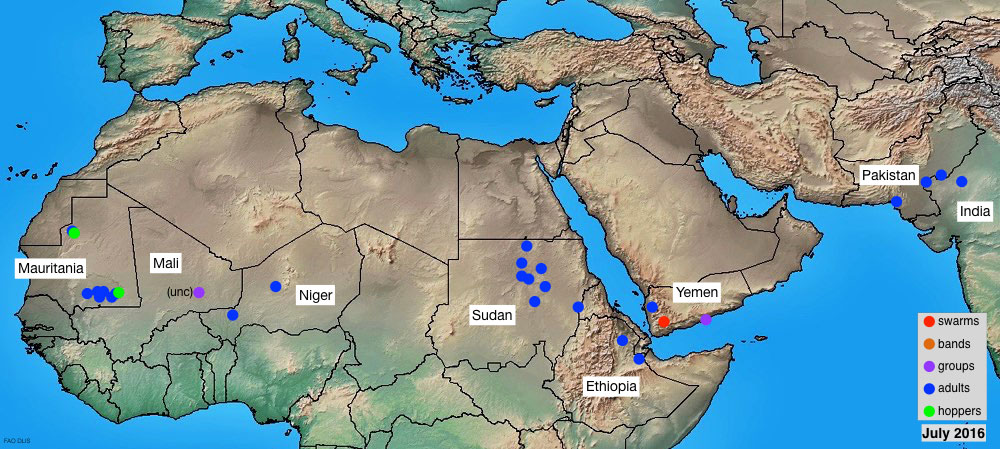
Current situation.
5 July. Swarms continue to form in Yemen and damage crops
The Desert Locust situation remains extremely serious in Yemen. New swarms have continued to form in the interior during the past two weeks. Some of the swarms moved into the central highlands and may continue to the Red Sea coast while others could still move to the summer breeding areas along the Indo-Pakistan border. Crop damage was reported in parts of Shabwah, Hadhramaut, Marib and Al Jawf regions. More swarms are expected to form during July and another generation of breeding could commence in August. Survey and control operations remain extremely limited due to prevailing insecurity.
Elsewhere, the Desert Locust situation is generally calm. Breeding ended in southern Morocco and northern Mauritania, and low numbers of adults are moving towards summer breeding areas in southern Mauritania. Isolated adults are present in northern Niger. Seasonal rains commenced in parts of the northern Sahel between Mauritania and Sudan where small-scale breeding will cause locust numbers to increase slightly during the summer. Isolated adults are present on the northwestern coast of Somalia and in northern Oman. In Northwest Africa, a few small hopper groups were treated near irrigated agricultural areas in central Algeria.
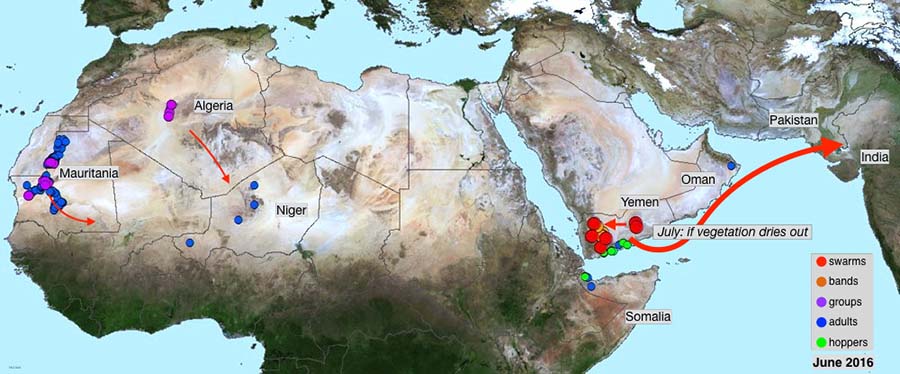
Current situation.
18 June. Swarms form in Yemen and may threaten Indo-Pakistan
As expected, numerous groups and swarms of Desert Locust adults started to form in several places in the interior of Yemen during the past week. Swarms are continuing to form, mainly in the summer breeding areas of Hadhramaut, Shabwah, Marib and Al Jawf governorates from breeding that occurred in April and May. Some of the swarms have attacked crops. New infestations of fifth instar hopper bands were recently discovered about 50 km southeast of Sana'a in Khawlan district.
FAO is providing assistance to Yemen but survey and control operations remain severely hampered by insecurity and beekeeping. Some of the infestations are present in very remote places that are difficult to access.
Although it has not rained in the interior since April, rains may fall in early July. If so, vegetation will stay green and the swarms should remain and mature in the interior between Marib and Thamud where they will lay eggs in about mid-July. On the other hand, if rains do not occur, ecological conditions will dry out and the swarms are more likely to move south to the Gulf of Aden where strong south-westerly monsoon winds would carry them through coastal areas of Oman and across the Arabian Sea to the Indo-Pakistan summer breeding area. Their arrival would nearly coincide with that of the monsoon rains in Rajasthan and adjacent areas of Pakistan. Swarm movement from the Yemen interior to Saudi Arabia is not very likely.
All efforts are required to increase survey and control operations in Yemen wherever possible and to remain vigilant in other countries. FAO will continue to monitor the developing situation closely and provide timely early warning.
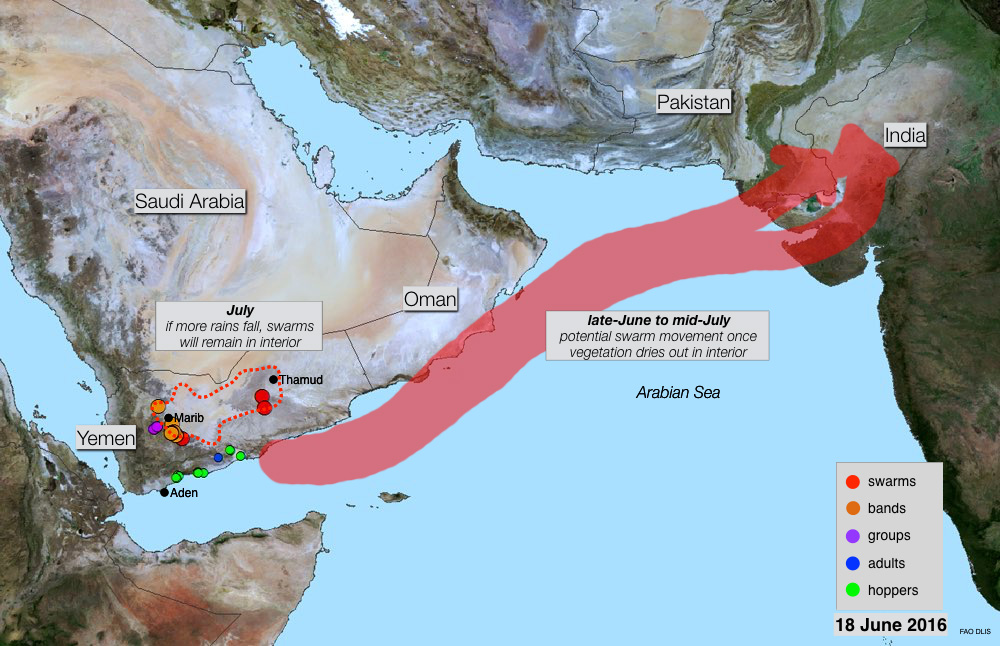
Yemen swarm threat to Indo-Pakistan summer breeding areas.
3 June. Swarms expected to form in Yemen may threaten Indo-Pakistan
The Desert Locust situation in Yemen continues to deteriorate as more hopper groups and bands formed in the interior as well as on the Aden coast during May. Insecurity and remoteness are hampering current survey and control efforts. Consequently, swarms will start to form in the coming days.
If vegetation remains green, the swarms are expected to remain in the interior between Marib and Thamud where they will mature with the possibility of another generation of egg-laying by mid-July. On the other hand, if vegetation dries out, then the swarms are likely to move south to the Gulf of Aden where strong south-westerly monsoon winds would carry them through coastal areas of Oman and across the Arabian Sea to the Indo-Pakistan summer breeding area. Their arrival would nearly coincide with that of the monsoon rains in Rajasthan and adjacent areas of Pakistan. Swarm movement from the Yemen interior to Saudi Arabia is not very likely.
All efforts are required to increase survey and control operations in Yemen wherever possible and to remain vigilant in other countries. FAO will continue to monitor the developing situation closely and provide timely early warning.
Elsewhere, the Desert Locust situation is generally calm. Control operations continue against adult groups in the southern part of the Western Sahara in southern Morocco and adjacent areas of northern Mauritania. A limited number of groups are likely to reach the summer breeding areas in southern Mauritania and lay eggs with the onset of the seasonal rains. Control operations were carried out during May against locally-bred adult groups in central Algeria.
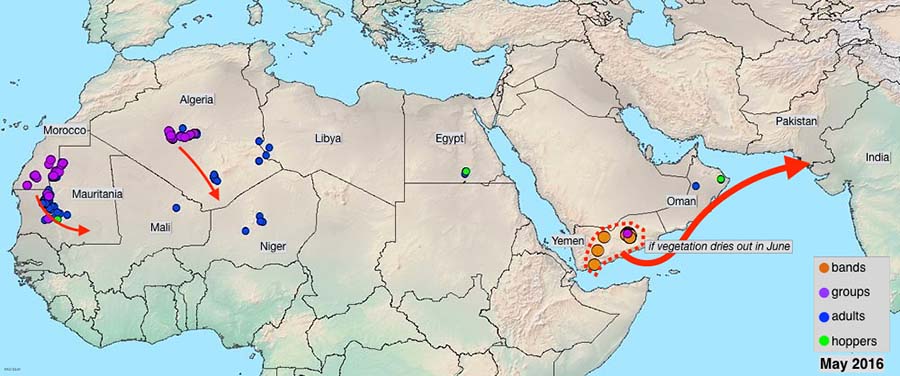
Current situation.
18 May. Swarms likely to form in Yemen
The Desert Locust situation continues to remain extremely alarming in Yemen. Breeding is in progress in the interior desert where good rains fell in November from two cyclones and again in April. As a result, ecological conditions continue to be favourable and locust numbers are increasing. Hatching and hopper band formation are currently under way. Hoppers will start to fledge in about two weeks and the new adults will form immature swarms from early June onwards. These swarms are expected to fly about within the interior as long as vegetation remains green.
The scale of the current outbreak is not well known. The few national survey teams currently active in the field cannot check many areas due to insecurity and remoteness. So far, teams have found hoppers bands in central areas of Wadi Hadhramaut and in numerous wadis on the rugged plateau to the north between Thamud and Minwakh. This area is extremely remote and difficult to access. Consequently, only a small portion of this area has been surveyed so far. Hopper bands have also been reported in desert areas west of Al Abr and near Bayhan as well as on the southern coast near Aden. This suggests that breeding has occurred over a large portion of the interior and many more locust infestations are likely to be present than are currently reported.
In the past few days, ground teams treated 39 ha but control operations are hampered by insecurity, remoteness and the presence of beekeepers and herders. Once swarms do form, control operations will become more difficult.
If breeding conditions continue to remain favourable in the interior of Yemen, there is a possibility that the swarms which form will move about between Marib and Thamud, mature and lay eggs from early July onwards. If so, this will result in a further substantial increase in locust numbers. On the other hand, if vegetation starts to dry out, then the swarms are likely to move south in June towards the Gulf of Aden where the southwest monsoon winds could carry them to the summer breeding areas along both sides of the Indo-Pakistan border in time for the arrival of the seasonal monsoon rains.
All efforts are required to mobilize additional field teams for survey and control operations in the interior of Yemen wherever it is safe and possible in order to determine the extent of current infestations and reduce swarm formation and subsequent breeding or migration.
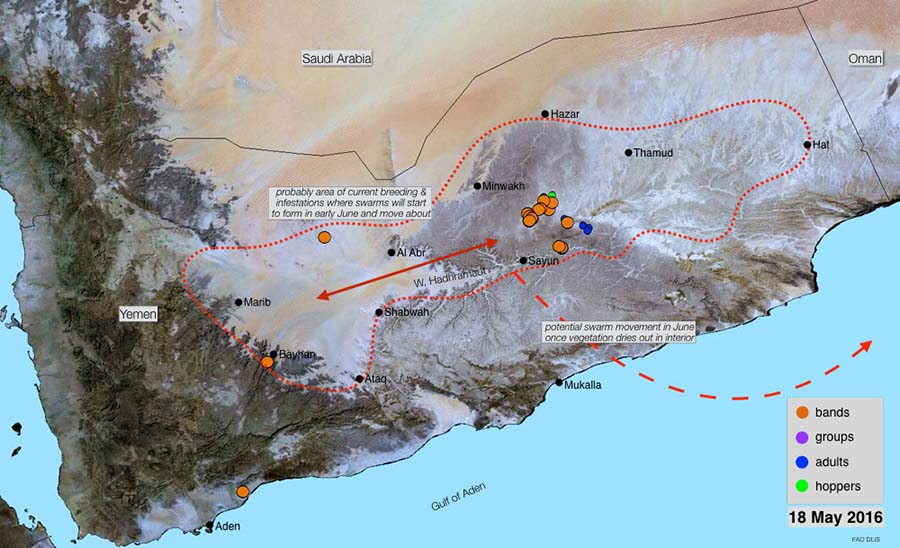
Current situation in Yemen.
2 May. Desert Locust situation worsens in Yemen
The Desert Locust situation has worsened in Yemen as adult groups and a few small swarms formed on the southern coast in early April and moved into the interior where widespread rains led to rapid maturation and egg-laying. Hatching and band formation commenced by the end of the month.
The extent and scale of current breeding are not well known due to the difficulty of undertaking surveys in the interior of Yemen. However, infestations are likely to be scattered throughout a large, remote and insecure area from Marib to Thamud where control operations cannot be carried out easily. Widespread hatching is expected during May that will cause numerous hopper groups and bands to form, followed by a high risk of swarm formation in June.
In Northwest Africa, control operations continue against a declining number of hopper and adult groups in the southern part of the Western Sahara in southern Morocco and adjacent areas of northern Mauritania. As vegetation continues to dry out, adult groups and perhaps a few small swarms may still form and could move in two different directions. Some could move south on lower level northerly winds into oases in western and central Mauritania and perhaps continue towards the summer breeding areas in southern Mauritania and maybe reach northern Senegal. Others could move northeast on upper level southwesterly winds to the central Sahara in Algeria where scattered adults are already present and breeding on a small scale. All efforts are required to monitor the situation carefully and undertake control when necessary in the concerned countries.
Elsewhere, the situation remains calm. Small-scale breeding is in progress in northern Oman and southeast Iran but locust numbers will remain low. Scattered adults are present in northern Mali and Niger, and on the Red Sea coast in Yemen and southern Eritrea.
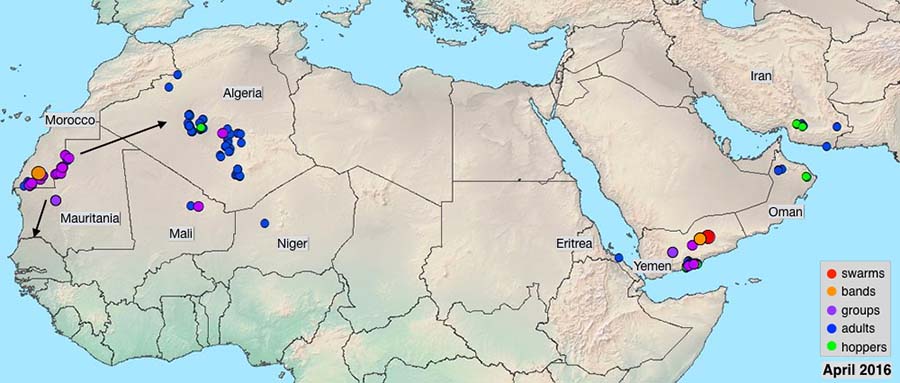
Current situation.
18 April. Desert Locust outbreak spreads to Yemen interior
During the first half of April, several Desert Locust adult groups and swarms formed in at least one area along the southern coast of Yemen between Arkha and Bir Ali. As vegetation dried out, the locusts moved into adjacent interior areas where heavy rains fell recently in Al Jawf, Marib, Hadhramaut, Shabwah and Al-Maharah regions. Consequently, infestations declined on the coast but increased in the interior. On 14 April, there were confirmed reports of at least one swarm and dense groups of adults that were copulating and laying eggs in several wadis on the interior plateau between Thamud and Wadi Hadhramaut. This was followed by additional reports of adult groups at the western end of Wadi Hadhramaut between Al Sor and Al Aber.
The full extent of infestations in the interior is not well known at present due to difficulties in mounting surveys in insecure and remote areas. Nevertheless, there remains a high risk that locust numbers will increase further given the widespread heavy rains that have fallen so far this month in the interior. Breeding is already underway in some areas with hatching expected to commence by the end of April and continue during May when hopper groups and bands are likely to form. New swarms could form in the interior from early June onwards. All efforts should be made to undertake surveys wherever possible and to organize control against the hoppers once they hatch and form groups and bands.
In addition, there remains a low to moderate risk that a few adult groups and perhaps small swarms may have reached southern areas in Saudi Arabia and maybe Oman, UAE and southeast Iran on strong, persistent southerly and southwesterly winds during the first half of April. These countries should be alert and remain vigilant.
On the central Red Sea coast of Yemen, heavy rains fell northeast of Zabid. Although this is less likely to have an impact on the current Desert Locust situation in the interior, surveys should be conducted to monitor the situation.
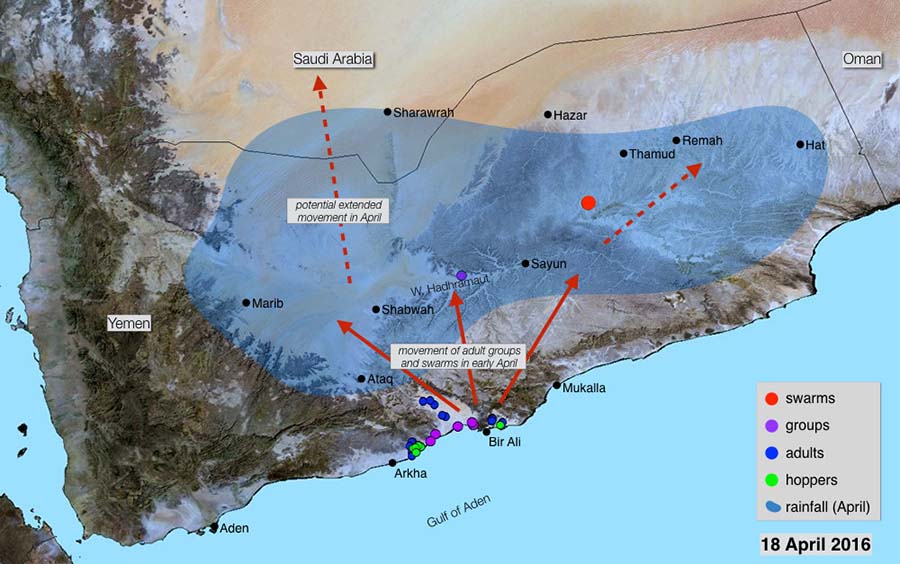
Current situation in Yemen.
5 April. Potentially dangerous locust situation developing in Yemen
A potentially dangerous situation is developing in southern Yemen where hopper bands and at least one swarm formed in areas that received heavy rains last November from cyclones Chapala and Megh. FAO is currently mobilizing support in order to respond to the situation. Nevertheless, as survey and control operations are presently limited by insecurity, locust numbers are expected to increase further, giving rise to more adult groups and swarms that are likely to move along the coast and into the interior, possibly reaching spring breeding areas in central Saudi Arabia, northern Oman and southeast Iran. These countries should take the necessary precautionary measures.
In Northwest Africa, hundreds of small hopper bands formed in the southern part of the Western Sahara in southern Morocco and hopper groups formed in adjacent areas of northern Mauritania. Ground control operations are in progress in both areas, having treated 5,000 ha in Morocco and nearly 700 ha in Mauritania during March. Two aircraft are currently on standby in southern Morocco. During April, adult groups and perhaps a few small small swarms could form and move to spring breeding areas south of the Atlas Mountains in Morocco and Algeria. Strict vigilance is required in all areas.
Elsewhere, the situation remains calm with only low numbers of adults present in northern Mali and Niger, southwest Libya, southeast Egypt and northeast Oman.
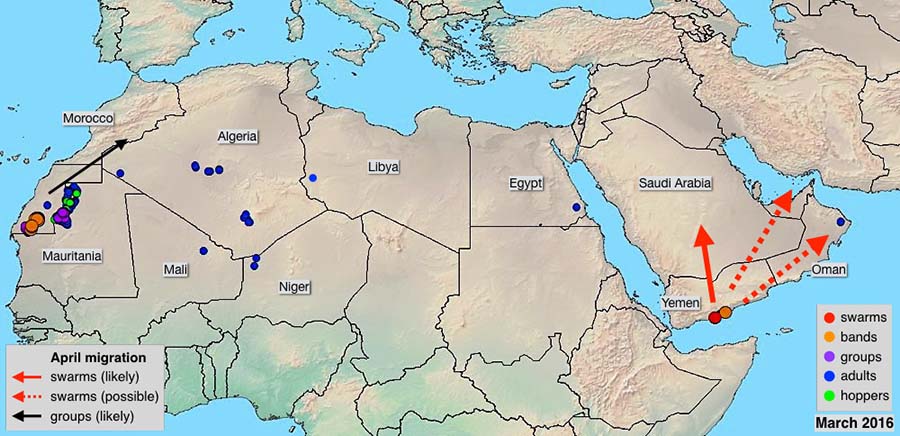
Current situation.
25 March. Hopper bands and adult groups forming on southern coast of Yemen
A potentially dangerous situation may be developing in southern Yemen where low numbers of immature and mature Desert Locust adults were initially seen on the coast by national survey teams on 10 March. This was the first confirmed report of locusts in areas that received heavy rainfall in early November 2015 from cyclones Chapala and Megh.
During subsequent surveys, teams found that a few adults are still laying eggs. But more importantly, numerous small hopper bands and groups of all instars are present on the southern coast between Arkha and Bir Ali (southwest of Mukalla) from egg-laying and hatching during February. A previous generation of breeding may have occurred shortly after the cyclone but was not detected.
Some of the current hopper infestations have already fledged and the new transiens and gregarious adults have formed small groups. Infestations are thought to be present along about 120 km of coastal plains that are up to about 20 km in width. Numerous beekeepers, camels and nomads are present in these areas, making control operations difficult.
As the November rains fell over a large portion of southern Yemen, it is not immediately known if other areas along the coast or in the interior are currently infested with Desert Locust due to prevailing insecurity. In most areas, ecological conditions remain favourable and will allow breeding to continue that will cause locust numbers to increase further. Consequently, there is a high risk of more hopper bands and adult groups forming, including the possibility of a few small swarms, in March and April. Once conditions dry out along the coast, the adults will continue to form small groups and perhaps a few small swarms that will move into the interior where breeding is likely in Marib, Shabwah and Hadhramaut regions between Marib, Ataq and Thamud. Rains recently fell in some of these areas. There is also a risk that some adult groups and perhaps a few small swarms could move northeast along the coast to southern Oman.
Substantive efforts are required to monitor the situation in all areas and undertake the necessary control operations whenever possible to avoid a further escalation.
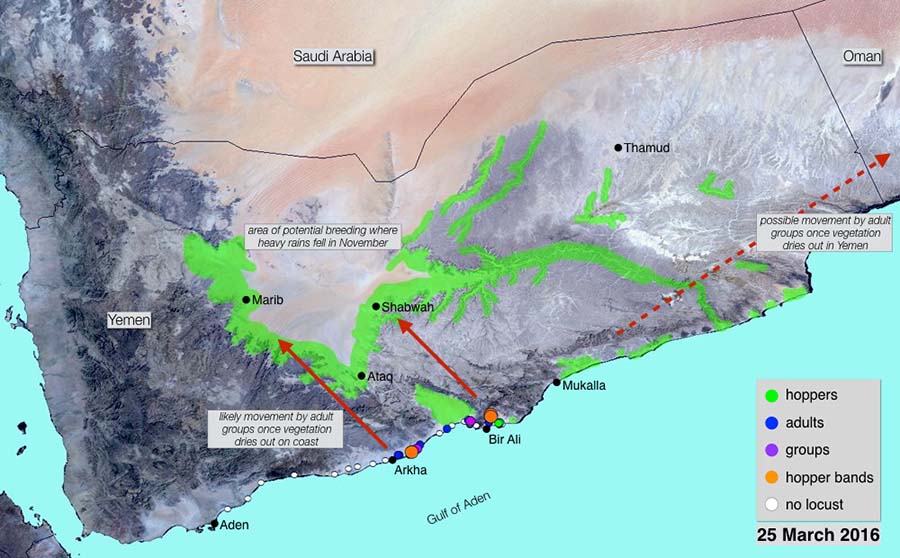
Current situation in Yemen.
3 March. Breeding continuing in NW Africa while other areas remain calm
Desert Locust breeding is still in progress in northern Mauritania and in adjacent areas of Western Sahara where locusts formed small groups of adults and, to a lesser extent, hoppers. Ground control operations have increased in both areas. Although breeding is likely to continue during March and cause a further increase in locust numbers and the formation of hopper and adult groups, the situation is expected to remain under control. As temperatures increase, low to moderate numbers of adults could move to spring breeding areas south of the Atlas Mountains in Morocco and Algeria and breed if rainfall occurs.
In the Central Region, low numbers of locusts continue to persist in parts of the winter breeding areas along both sides of the Red Sea in Sudan, Saudi Arabia and Yemen. As very little rain has fallen recently, vegetation is drying out and breeding is expected to decline in the winter breeding areas. The situation remains less clear in the interior of southern Yemen where ecological conditions are expected to be favourable as a result of two cyclones in November. There is a risk that locusts may be present and breeding. If so, adult groups could form as vegetation dries out and move towards Oman.
In Southwest Asia, the situation remains calm. Small-scale breeding is likely to occur in parts of southeastern Iran.
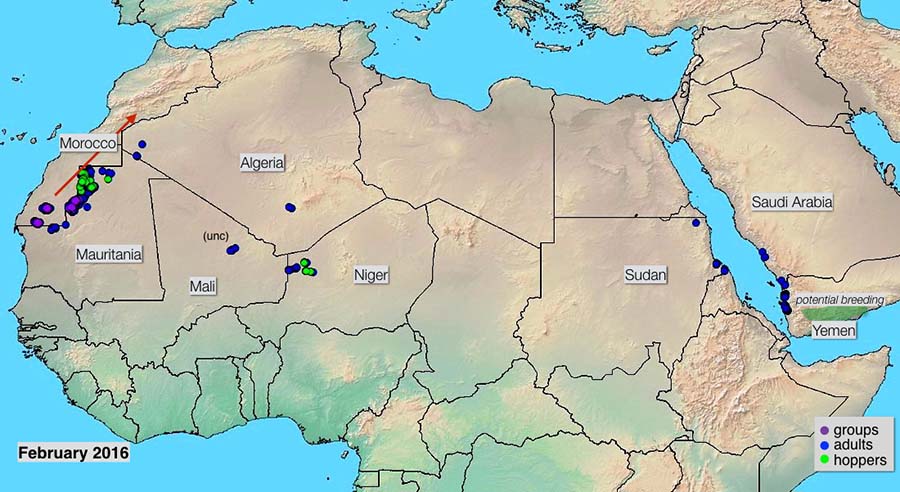
Current situation.
2 February. Breeding continues in NW Africa while Red Sea area remains calm
Desert Locust breeding is continuing in north and northwest Mauritania and in adjacent areas of Western Sahara where a few small groups formed recently. Limited ground control operations have been carried out in these areas. Breeding will continue during February and may cause a further increase in locust numbers and the formation of hopper and adult groups. As temperatures increase, some adults may move to spring breeding areas south of the Atlas Mountains in Morocco and Algeria.
In the Central Region, only low numbers of locusts are present in parts of the winter breeding areas along both sides of the Red Sea in Sudan, Eritrea, Saudi Arabia and Yemen. Unless further rains fall, breeding should decline in these areas as conditions become dry. In northern Somalia, only isolated adults have been detected on the northwest coast but good rains that fell last week may lead to small-scale breeding.
The situation remained calm in southwest Asia.
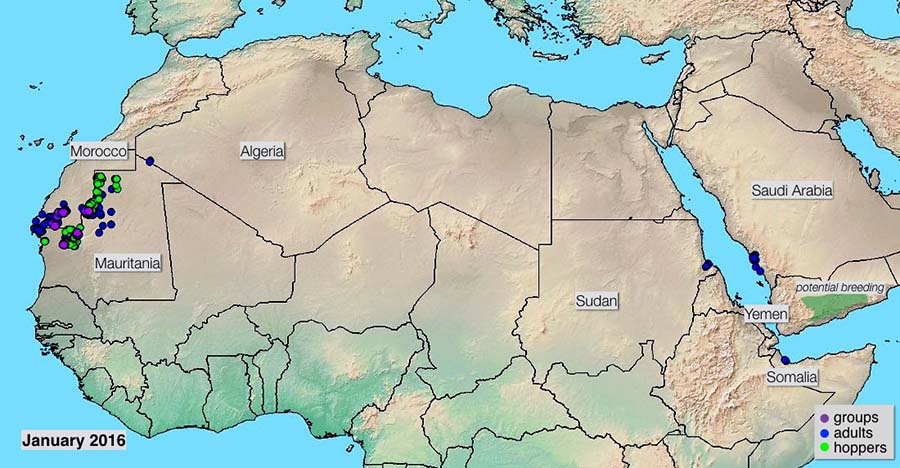
Current situation.
4 January. Control operations decline in Mauritania
Control operations declined in late December against hopper and adult groups that formed as a result of an outbreak in western Mauritania. Nevertheless, infestations and breeding has spread further north in the country as well as to adjacent areas of Western Sahara where limited control was undertaken. There remains a risk of further breeding that would cause locust numbers to increase and more groups and perhaps a few small hopper bands to form.
Although small-scale breeding occurred in northern Mali (Timetrine area) and in northern Niger (Tamesna) where a few small groups formed in December, only low numbers of adults are likely to persist in both areas during the coming months.
The situation remains calm in the winter breeding areas along both sides of the Red Sea. So far, only low numbers of solitarious adults have been reported on the coast of Sudan, Saudi Arabia and Yemen. Limited breeding occurred in Yemen. Ecological conditions are favourable in northeast Sudan and on the northwest coast of Somalia where small-scale breeding is expected in the coming months.
The situation remains calm in southwest Asia.
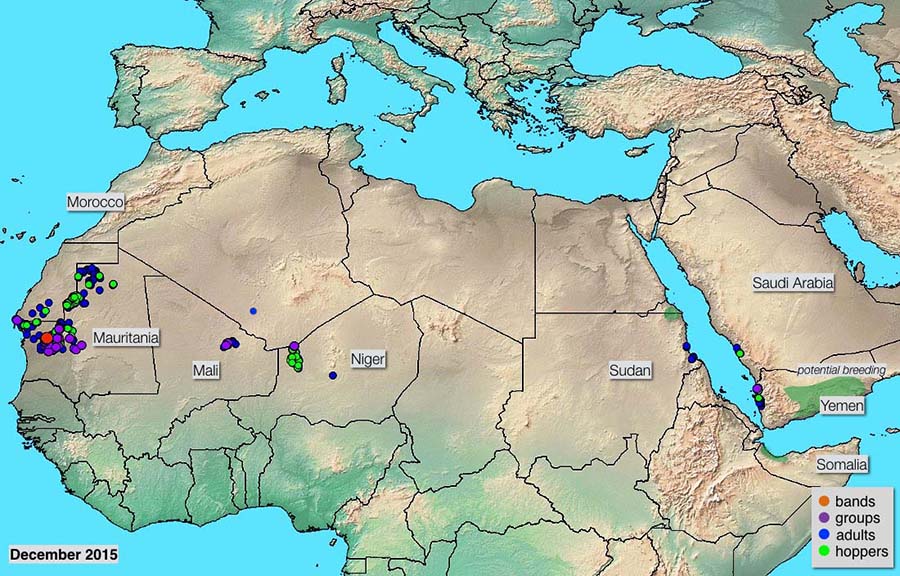
Current situation.




